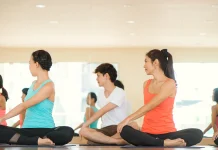Good posture can help you in ways you may not have thought of–with better looks, a stronger self-image, and even better health. While some people do need professional evaluation and advice, improving your posture is the kind of personal makeover you can mainly do for yourself.
Posture is not simply what happens when you are sitting or standing still. It’s also dynamic and involves the way you hold your body when you move. Poor posture may include many elements: rounded shoulders, protruding buttocks and abdomen, and an overly arched lower back; often the head is pushed forward into an exaggerated position.
There are many reasons for the problem, including previous injuries, disease, poor muscle tone, and emotional stress. A sedentary lifestyle can also reduce muscle tone and strength and create poor posture. In addition, sore, aching feet–and poorly fitting shoes as well as high heels–have a negative effect on the way you hold yourself.
“Straightening up” now and then isn’t enough, however. Retraining postural habits takes time and effort.
Evaluating your posture
You can begin to evaluate your posture with the aid of a full-length mirror and a hand mirror. Having a friend look at your posture will also help.
Stand before the mirror, wearing tight clothing (such as a swimsuit) and flat shoes; assume your normal posture and then check yourself as you:
Face sideways:
While standing, imagine dots at the front of your earlobe and shoulder, at the center of your hip, just behind your kneecap, and just in front of your ankle bone. Connect these dots–they should form a straight vertical line.
Notice how your back curves. There should be a mild inward curve behind your neck and lower back. Your upper back should curve slightly outward.
Check your chin. It should normally be parallel to the floor and not thrust forward.
Still checking your image in profile, sit in a straight, armless chair. You should still be able to draw a straight vertical line from ear lobe to hip, and the three natural curves of your back should be visible.
Face forward:
When standing, your hips, shoulders, and knees should be level–one hip (or shoulder or knee) should not be higher than the other. The spaces between your arms and waist should be the same on each side. Your kneecaps should face straight ahead. Your ankles should be straight (not rolling inward with your weight on the inside of your feet). Your head should be straight.
When sitting, your shoulders should be at equal height, knees facing forward, and ankles straight.
Posture Strategies
Keep the following important points in mind while standing, walking, lying down, or sitting, and your posture may begin to improve almost immediately:
While standing or walking
Think tall. Imagine a wire attached to the top of your head, pulling it upward. Avoid standing or walking swayback–that is, with an extreme curve in the lower back. Instead, lift your chest up, pull in your abdomen, and tuck in your buttocks.
Practice tightening your abdominal muscles and flattening your stomach. Hold the position for a few seconds, then relax. Repeat this occasionally throughout the day.
When standing for long periods, try to stand evenly balanced on both feet. If you get tired, shift your weight from one foot to another. Occasionally rest one foot on a small stool.
While lying down
Make sure your mattress is comfortable–it need not be hard, but it shouldn’t sag. Back pain in the morning may be a sign that the bed or your sleeping position is bad.
While sitting
For long periods of sitting, choose a straight-back chair. Sit firmly back in it with your shoulders against the chair, your chest lifted, and your upper back straight. Put a small lumbar roll against your lower back for additional support. Put equal weight on your left and right sit bones. Your feet should be flat on the floor, and your legs horizontal. If the chair is too high for this, use a phone book or small stool as a foot rest.
When working at a desk, angle your work so that you are not looking down. Lean forward at your hips, bringing your whole trunk forward, rather than bending at the waist or neck.
While driving
When driving, position your seat so you can easily reach the wheel, as well as the accelerator and brake.
Change the car seat position occasionally, tilting it slightly forward or back, if possible. Try a lumbar roll for your lower back.
During a long trip, stop every couple of hours to rest and stretch.
Practice good sitting posture while driving–don’t slump. Remember the imaginary wire at the top of your head, pulling it upward.
A final point
Try to maintain a healthy weight. Being overweight can cause or aggravate poor posture. Remember, regular exercise is not only good for your overall health; it also helps you control your weight–and improve your posture
Posture Principle
Posture is how you balance your body. If you don’t balance, you fall down. The human body is designed to move. It is much easier to walk for 30 minutes than to stand still for 30 minutes.
Posture, motion & balance depend on the bones, muscles, ligaments, and nerves. Bones support the structure of body. Ligaments hold bones together where they meet at movable joints. Muscles shorten (or contract) in specific patterns to create motion. Nerves control the muscles with messages from the brain.
The body learns what you teach it. Pain teaches the body to move differently. If it hurts to move, the body will adapt and move in a way to avoid pain.
The body will adapt to posture & motion changes. Over time, the stress of unbalanced posture and motion results in muscle imbalance and joint wear. This begins a vicious cycle of unbalanced motion – causing breakdown – causing more unbalanced motion. Constant muscle and joint stress causes chronic muscle spasm, joint damage (arthritis/DJD) and recurring injuries.
Try This:
Up Against The Wall
Stand up straight next to a wall placing your left shoulder against the wall.
Try and lift your right leg.
You cant!
Heres why:You cant shift to the left in order to balance.
Try This:
Mirror Mirror
Stand in front of a full-length mirror.
Lift your left leg and slowly count to 12.
Stop the first time you have to put your foot down to balance.
Repeat with your right leg.
How long can you balance on your left leg? On your right one? If you cant balance for 10 seconds on each side, your body is not evenly balanced. Unbalanced stress causes the body to adapt and change over time, ultimately causing problems and pain.
Try This:
Digital Motion
Slowly raise your hand above your head.
Put it back down, and lift it again, even slower (as slowly as you can).
Can you lift your hand slowly and smoothly? If you lift as slowly as possible, most people notice that the hand jumps slightly. Individual muscle fibers contract fully or not at all. You cannot move your hand smoothly and slowly because the individual muscle fibers contract in unison to create the appearance of smooth motion. When you slow down the motion, you can see the “gaps” in the motion from less or unused muscle fibers. A ballet dancer or athlete moves with grace and control because the motion is smooth. This is why an elderly person who cannot control their muscles moves with a jerky walk.
Try This:
Dont Be Cross!
Cross your arms in front of you.
Is your left forearm or right forearm on top?
Now, cross your arms with the opposite forearm on top. (Be sure you have a different arm on top this time!)
This feels awkward to most people. Your “normal” or habitual pattern of motion is with one forearm on top. Reversing the top forearm makes your arms, shoulder girdle, and neck work opposite your habit pattern. As a very general rule of thumb, the more stuck in a pattern of motion (and therefore out of balance) one is, the more imbalanced one feels on doing a reverse arm cross. Some people are so fixed in their pattern of motion they are physically unable to cross their arms backwards.
Another observation of fixed patterns of motion is noting if your hands are above or tucked under your arms. Then, try to do the opposite of your normal pattern.
Try This:
Sole Searching
Look at the bottoms and sides of your shoes.
Are they worn the same on both sides?
If not, it is because they have worn to adapt to the stress of your walking unevenly on them. When the leather on the bottom of your shoes wears out unevenly you can buy new shoes. Where are you going to live when you wear out your body?





